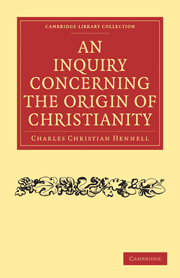Book contents
- Frontmatter
- PREFACE
- Contents
- ERRATA
- CHAPTER I Historical sketch, from the Babylonish captivity to the death of Jesus
- CHAPTER II Historical sketch, continued to the end of the first century
- CHAPTER III On the date and credibility of the Gospel of Matthew
- CHAPTER IV On the date and credibility of the Gospel of Mark
- CHAPTER V On the date and credibility of the Gospel of Luke
- CHAPTER VI On the date and credibility of the Gospel of John
- CHAPTER VII Examination of the accounts of the Resurrection and Ascension
- CHAPTER VIII Remarks on the other miracles in the four Gospels
- CHAPTER IX General objections to the miracles of Jesus
- CHAPTER X Remarks on the miracles in the Acts of the Apostles
- CHAPTER XI On the evidence afforded to the miracles by the apostolic writings
- CHAPTER XII On the prophecies
- CHAPTER XIII On the parts of Isaiah supposed to relate to Christ
- CHAPTER XIV On the book of Daniel
- CHAPTER XV Whether Jesus foretold his own death and resurrection
- CHAPTER XVI On the character, views, and doctrine of Jesus
- CHAPTER XVII Comparison of the precepts of Jesus with the Jewish writings
- CHAPTER XVIII Concluding reflections
- APPENDIX
CHAPTER XVII - Comparison of the precepts of Jesus with the Jewish writings
Published online by Cambridge University Press: 05 March 2012
- Frontmatter
- PREFACE
- Contents
- ERRATA
- CHAPTER I Historical sketch, from the Babylonish captivity to the death of Jesus
- CHAPTER II Historical sketch, continued to the end of the first century
- CHAPTER III On the date and credibility of the Gospel of Matthew
- CHAPTER IV On the date and credibility of the Gospel of Mark
- CHAPTER V On the date and credibility of the Gospel of Luke
- CHAPTER VI On the date and credibility of the Gospel of John
- CHAPTER VII Examination of the accounts of the Resurrection and Ascension
- CHAPTER VIII Remarks on the other miracles in the four Gospels
- CHAPTER IX General objections to the miracles of Jesus
- CHAPTER X Remarks on the miracles in the Acts of the Apostles
- CHAPTER XI On the evidence afforded to the miracles by the apostolic writings
- CHAPTER XII On the prophecies
- CHAPTER XIII On the parts of Isaiah supposed to relate to Christ
- CHAPTER XIV On the book of Daniel
- CHAPTER XV Whether Jesus foretold his own death and resurrection
- CHAPTER XVI On the character, views, and doctrine of Jesus
- CHAPTER XVII Comparison of the precepts of Jesus with the Jewish writings
- CHAPTER XVIII Concluding reflections
- APPENDIX
Summary
The Jewish writings quoted for this purpose will be the Scriptures of the Old Testament; the book of Ecclesiasticus, by Jesus the son of Sirach, written about 200 years before Christ; and the most ancient Rabbinical writings, viz.:
The Talmud, which consists of two parts, the Mishna and the Gemara. The Mishna, or first Talmud, is a collection of Pharisaic traditions made by Rabbi Jehuda Hakkadosh, A.D. 141, or, as some say, towards the close of the second century. The Gemara, or second part of the Talmud, consists of commentaries upon and additions to the Mishna, collected by Rabbi Jochanan ben Eliezer; and this addition completed the Jerusalem Talmud, A.D. 469. A similar collection was made at Babylon at the beginning of the sixth century, and called the Babylonian Talmud.
The book Sohar, or the Brightness, containing mystical interpretations of the Old Testament, chiefly those of R. Simeon ben Jochai, whose disciples made this compilation about A.D. 170.
The Midraschic books, containing collections of traditions, doctrines, and stories, derived from the schools of interpretation. These collections were made by some Rabbins, whose names are unknown, about the time of Christ, and during the first, second, third, and fourth centuries. The names of the books are, Tanchuma, Rabboth, Pirke R. Eliezer, Mechilta, Siphra, Siphre, Pesikta Robbetha, Pesikta Sotarta, Midrasch Schmuel, Tehillim, and Mischle.
Since all these Rabbinical books were compiled after the time of Christ, it appears at first sight that no quotations from them can affect the question of the originality of the precepts of the Gospels.
- Type
- Chapter
- Information
- An Inquiry Concerning the Origin of Christianity , pp. 334 - 356Publisher: Cambridge University PressPrint publication year: 2010First published in: 1838



